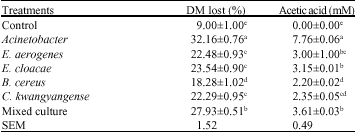Research Article
Digestion of Rice Straw and Oil Palm Fronds by Microflora from Rumen and Termite Bacteria, in vitro
Department of Animal Science, Faculty of Agriculture, 43400 UPM Serdang, Selangor, Malaysia
A.R. Alimon
Department of Animal Science, Faculty of Agriculture, 43400 UPM Serdang, Selangor, Malaysia
J.M. Panandam
Department of Animal Science, Faculty of Agriculture, 43400 UPM Serdang, Selangor, Malaysia
K. Sijam
Department of Plant Protection, Faculty of Agriculture, Universiti Putra Malaysia, 43400 UPM Serdang, Selangor, Malaysia
A. Javanmard
Department of Animal Science, Faculty of Agriculture, 43400 UPM Serdang, Selangor, Malaysia
N. Abdullah
Institute of Tropical Agriculture, 43400 UPM Serdang, Selangor, Malaysia












